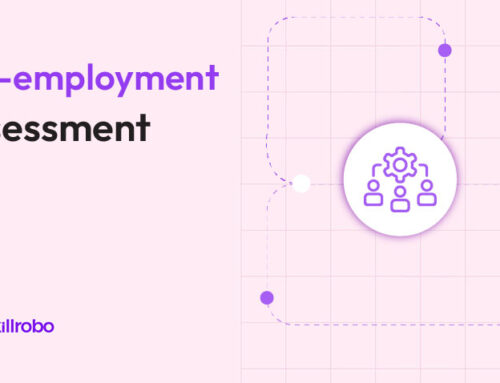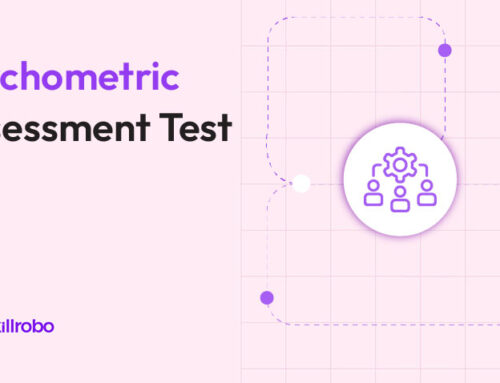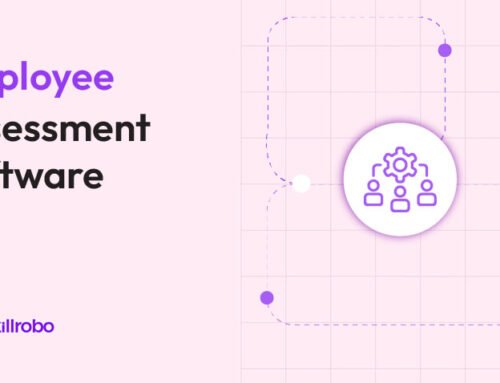Table of Contents
Related articles

With the rapid advancement in technology, online exams have become popular due to their convenience and ease of administration. However, with the ease of taking online exams, comes the risk of cheating. Candidates can cheat using various methods and tools, making it challenging for teachers and institutions to detect and prevent them. People use their uncertainty and lack of expertise to find loopholes and earn better results without putting in much time. Also, every area tries to adapt to the new learning environment by introducing various remote proctoring options. This article will discuss eleven creative ways of cheating in online exams and how to prevent them.
Why is Cheating such a Big Concern in Hiring?
Cheating in hiring is a significant concern because it can lead to serious consequences for both the organization and the individual involved. Hiring is a critical process for any organization, as it involves selecting individuals who will be entrusted with important responsibilities and represent the company’s values and culture.
When an individual cheats during the hiring process through online exams, it can give them an unfair advantage over other candidates who have followed the rules and may be more qualified for the position. This can lead to a situation where the organization hires an individual who may not be the best fit for the role, potentially resulting in poor job performance and negative impacts on the team or organization.
Moreover, cheating can damage the integrity of the hiring process and the organization’s reputation, especially if the cheating becomes public knowledge. It can also create legal and ethical issues, as cheating can involve falsifying credentials or providing inaccurate information about one’s qualifications, which can lead to legal liability for the organization.
What is a Proctored Test and how does it Function in the Recruiting Process?
A proctored test is an evaluation that is monitored by a proctor or an invigilator, who is responsible for ensuring that the exam is taken fairly and according to the rules. Proctored exams are often used in the hiring process to prevent cheating and ensure that the candidate’s skills and knowledge are accurately assessed.
During a proctored exam, the proctor may monitor the exam in person or remotely, using video conferencing or specialized software. The proctor will verify the candidate’s identity, explain the exam rules, and monitor the candidate’s behavior to ensure that they are not cheating.
Online proctored exams follow a similar procedure to traditional in-person exams. Students must complete the identification process and prove their identity before starting the evaluation. As a result, the system will cross-check data from two distinct sources after they enable their webcams and submit a photo or scan of their ID. A student can start the test after having their identity satisfactorily verified and their necessary equipment checked.
The proctoring software will detect any suspicious behavior by test takers and, depending on the type of software, either warn the human proctor or generate a report for further investigation. Moreover, online proctoring comprises recording all the data in addition to spotting dishonesty in real-time, enabling the review of test outcomes if any disputable circumstances arise.
11 Clever Ways Candidates Cheat on Online Proctored Exams & How to Prevent Them
Online exams have become a popular form of assessment in recent times, especially with the rise of remote learning. While online exams offer many benefits, they also pose a risk of cheating by candidates. With the help of technology and the internet, candidates can use various creative ways to cheat during online exams. Here are eleven such ways and how to prevent them.
1. Using External Devices
Many people are aware that most on-screen activities are often blocked by remote proctoring software. So that a helper may see the exam material and indicate the correct answers, they choose to mirror their desktop screen to an external display or projector. Candidates may use external devices such as smartphones, tablets, or smartwatches to cheat during online exams. They can use these devices to access notes, search for answers, or communicate with other individuals.
Prevention: Prohibit the use of external devices during the exam. Use online proctoring software that can detect any device connected to the candidate’s computer.
2. Screen Sharing
Candidates can use screen-sharing tools to show their exam screen to another person who can help them with the answers.
Prevention: Use proctoring software that can detect screen sharing and alert the exam supervisor.
3. Copy-Pasting
Candidates can copy-paste answers from online sources or their notes.
Prevention: Use software that can detect plagiarism and check for duplicate answers.
4. Virtual Machines
A virtual machine is a setup that resembles a computer. Some candidates enable a virtual machine as an additional operating system to look up the test question’s answers while proctoring software watches the device’s primary operating system (OS). Candidates can use virtual machines to run multiple instances of the exam, allowing them to search for answers without leaving the exam interface.
Prevention: Use software that can detect virtual machines and prohibit their use.
5. Impersonation
One of the most typical forms of misbehavior is this. It suggests that candidates request that another person take an exam on their behalf. Often, impersonation occurs either before or during an online assessment session. Before the authentication, pupils in the first scenario try to find a means to switch places with someone else. For instance, they might modify their identification papers or swap exam login information. Some pupils choose to confirm their identification on their own before yielding to a faker. This situation is also common because most online proctoring systems only undertake authentication and verification before the test begins, making it impossible to prevent this kind of dishonesty.
Prevention: Use identity verification measures such as facial recognition or biometric authentication to ensure that the person taking the exam is a registered candidate. Additionally, it is suggested to utilize AI-based proctoring software that can identify shady sounds, other gadgets, and unusual body language.
6. Collaboration
Candidates can collaborate with other candidates or individuals during the exam, either by chatting or through video conferencing.
Prevention: Use software that can detect multiple logins from the same IP address and prohibit communication during the exam.
7. Fake IDs
During in-person tests, a proctor or facilitator can verify the candidate’s identity. Yet, when tests are given online, especially those that are not proctored or monitored, it is considerably more difficult to guarantee that only the appropriate people can take them. Candidates can have others impersonate them by displaying rigged identifications, such as a fake driver’s license or school identification card, which may be difficult to confirm virtually even when a proctor is watching via webcam.
Prevention: Use identity verification measures such as government-issued IDs or biometric authentication.
8. Keyloggers
Candidates can use keyloggers to capture keystrokes, enabling them to know the answers typed by the previous candidate.
Prevention: Use software that can detect keyloggers and prevent their installation.
9. Cheating Websites
Candidates can use websites that provide answers to exam questions.
Prevention: Use software that can detect access to known cheating websites and prohibit access to these websites.
10. Brute Force
Candidates can use brute force to guess passwords or break encryption to gain access to the exam.
Prevention: Use strong passwords and encryption algorithms that are difficult to guess or break.
11. Malware
Candidates can use malware to gain access to the exam or the computer of the supervisor.
Prevention: Use antivirus software and firewalls to detect and prevent malware infections.
Online exams are susceptible to cheating, and candidates can use creative ways to cheat during exams. However, using software that can detect cheating techniques and implementing preventive measures can help ensure the integrity of online exams.
How can Online Exam Cheating be Reduced?
Online exam cheating during the recruitment process can be reduced through various measures. Here are some effective strategies to consider:
- Use proctoring software: One of the most effective ways to reduce online exam cheating is to use proctoring software. This software can monitor a candidate’s computer activity, webcam, and microphone during the exam to ensure that they are not using any unauthorized resources or getting assistance from others.
- Randomize exam questions: Another way to reduce cheating is to randomize the exam questions so that no two candidates have the same set of questions. This will make it more difficult for candidates to share answers.
- Use AI-powered anti-cheating tools: AI-powered anti-cheating tools can analyze a candidate’s behavior during the exam and flag any suspicious activity. These tools can help detect patterns of cheating, such as copy-pasting answers or using online resources.
- Use plagiarism detection software: Plagiarism detection software can be used to detect if a candidate has copied answers from online sources or submitted someone else’s work as their own.
- Verify candidate identity: Verify the identity of candidates by requesting identification documents, such as a passport or driver’s license, and comparing them to the candidate’s photo or webcam feed.
- Create a code of conduct: Establish a code of conduct that clearly outlines the rules and consequences of cheating during the exam. Make sure to communicate this code to all candidates beforehand. By implementing these measures, online exam cheating can be significantly reduced, and the recruitment process can be more transparent and fair for all candidates.
Conclusion
We now have the ability to unleash stringent and safe testing solutions because of numerous technological breakthroughs. Its inclusion at every level of the examination system is helping educators overcome big problems. Online proctoring technologies are the underdog.
A cutting-edge online monitoring system called proctoring was created with AI to modernize exams and evaluations. Facilitating the secure hosting of online exams (an anti-cheating design for online exams) and automatically identifying cheating in online assessments, opens up a new career route for educators.
And AI’s integrity will keep improving as long as proctoring technologies are employed to prevent test-takers from cheating during online exams. Institutions or businesses that use online exams must therefore use the most recent AI-driven proctoring solutions. Skillrobo is a pre-employment assessment test platform that provides a complete proctoring system while taking exams or tests. This will help the organization filter the perfect candidate from cheating during online recruitment. Also, it will aid in getting rid of any potential candidate exam-cheating strategies. To explore Skillrobo, Sign Up for the free trial right away.

With the rapid advancement in technology, online exams have become popular due to their convenience and ease of administration. However, with the ease of taking online exams, comes the risk of cheating. Candidates can cheat using various methods and tools, making it challenging for teachers and institutions to detect and prevent them. People use their uncertainty and lack of expertise to find loopholes and earn better results without putting in much time. Also, every area tries to adapt to the new learning environment by introducing various remote proctoring options. This article will discuss eleven creative ways of cheating in online exams and how to prevent them.
Why is Cheating such a Big Concern in Hiring?
Cheating in hiring is a significant concern because it can lead to serious consequences for both the organization and the individual involved. Hiring is a critical process for any organization, as it involves selecting individuals who will be entrusted with important responsibilities and represent the company’s values and culture.
When an individual cheats during the hiring process through online exams, it can give them an unfair advantage over other candidates who have followed the rules and may be more qualified for the position. This can lead to a situation where the organization hires an individual who may not be the best fit for the role, potentially resulting in poor job performance and negative impacts on the team or organization.
Moreover, cheating can damage the integrity of the hiring process and the organization’s reputation, especially if the cheating becomes public knowledge. It can also create legal and ethical issues, as cheating can involve falsifying credentials or providing inaccurate information about one’s qualifications, which can lead to legal liability for the organization.
What is a Proctored Test and how does it Function in the Recruiting Process?
A proctored test is an evaluation that is monitored by a proctor or an invigilator, who is responsible for ensuring that the exam is taken fairly and according to the rules. Proctored exams are often used in the hiring process to prevent cheating and ensure that the candidate’s skills and knowledge are accurately assessed.
During a proctored exam, the proctor may monitor the exam in person or remotely, using video conferencing or specialized software. The proctor will verify the candidate’s identity, explain the exam rules, and monitor the candidate’s behavior to ensure that they are not cheating.
Online proctored exams follow a similar procedure to traditional in-person exams. Students must complete the identification process and prove their identity before starting the evaluation. As a result, the system will cross-check data from two distinct sources after they enable their webcams and submit a photo or scan of their ID. A student can start the test after having their identity satisfactorily verified and their necessary equipment checked.
The proctoring software will detect any suspicious behavior by test takers and, depending on the type of software, either warn the human proctor or generate a report for further investigation. Moreover, online proctoring comprises recording all the data in addition to spotting dishonesty in real-time, enabling the review of test outcomes if any disputable circumstances arise.
11 Clever Ways Candidates Cheat on Online Proctored Exams & How to Prevent Them
Online exams have become a popular form of assessment in recent times, especially with the rise of remote learning. While online exams offer many benefits, they also pose a risk of cheating by candidates. With the help of technology and the internet, candidates can use various creative ways to cheat during online exams. Here are eleven such ways and how to prevent them.
1. Using External Devices
Many people are aware that most on-screen activities are often blocked by remote proctoring software. So that a helper may see the exam material and indicate the correct answers, they choose to mirror their desktop screen to an external display or projector. Candidates may use external devices such as smartphones, tablets, or smartwatches to cheat during online exams. They can use these devices to access notes, search for answers, or communicate with other individuals.
Prevention: Prohibit the use of external devices during the exam. Use online proctoring software that can detect any device connected to the candidate’s computer.
2. Screen Sharing
Candidates can use screen-sharing tools to show their exam screen to another person who can help them with the answers.
Prevention: Use proctoring software that can detect screen sharing and alert the exam supervisor.
3. Copy-Pasting
Candidates can copy-paste answers from online sources or their notes.
Prevention: Use software that can detect plagiarism and check for duplicate answers.
4. Virtual Machines
A virtual machine is a setup that resembles a computer. Some candidates enable a virtual machine as an additional operating system to look up the test question’s answers while proctoring software watches the device’s primary operating system (OS). Candidates can use virtual machines to run multiple instances of the exam, allowing them to search for answers without leaving the exam interface.
Prevention: Use software that can detect virtual machines and prohibit their use.
5. Impersonation
One of the most typical forms of misbehavior is this. It suggests that candidates request that another person take an exam on their behalf. Often, impersonation occurs either before or during an online assessment session. Before the authentication, pupils in the first scenario try to find a means to switch places with someone else. For instance, they might modify their identification papers or swap exam login information. Some pupils choose to confirm their identification on their own before yielding to a faker. This situation is also common because most online proctoring systems only undertake authentication and verification before the test begins, making it impossible to prevent this kind of dishonesty.
Prevention: Use identity verification measures such as facial recognition or biometric authentication to ensure that the person taking the exam is a registered candidate. Additionally, it is suggested to utilize AI-based proctoring software that can identify shady sounds, other gadgets, and unusual body language.
6. Collaboration
Candidates can collaborate with other candidates or individuals during the exam, either by chatting or through video conferencing.
Prevention: Use software that can detect multiple logins from the same IP address and prohibit communication during the exam.
7. Fake IDs
During in-person tests, a proctor or facilitator can verify the candidate’s identity. Yet, when tests are given online, especially those that are not proctored or monitored, it is considerably more difficult to guarantee that only the appropriate people can take them. Candidates can have others impersonate them by displaying rigged identifications, such as a fake driver’s license or school identification card, which may be difficult to confirm virtually even when a proctor is watching via webcam.
Prevention: Use identity verification measures such as government-issued IDs or biometric authentication.
8. Keyloggers
Candidates can use keyloggers to capture keystrokes, enabling them to know the answers typed by the previous candidate.
Prevention: Use software that can detect keyloggers and prevent their installation.
9. Cheating Websites
Candidates can use websites that provide answers to exam questions.
Prevention: Use software that can detect access to known cheating websites and prohibit access to these websites.
10. Brute Force
Candidates can use brute force to guess passwords or break encryption to gain access to the exam.
Prevention: Use strong passwords and encryption algorithms that are difficult to guess or break.
11. Malware
Candidates can use malware to gain access to the exam or the computer of the supervisor.
Prevention: Use antivirus software and firewalls to detect and prevent malware infections.
Online exams are susceptible to cheating, and candidates can use creative ways to cheat during exams. However, using software that can detect cheating techniques and implementing preventive measures can help ensure the integrity of online exams.
How can Online Exam Cheating be Reduced?
Online exam cheating during the recruitment process can be reduced through various measures. Here are some effective strategies to consider:
- Use proctoring software: One of the most effective ways to reduce online exam cheating is to use proctoring software. This software can monitor a candidate’s computer activity, webcam, and microphone during the exam to ensure that they are not using any unauthorized resources or getting assistance from others.
- Randomize exam questions: Another way to reduce cheating is to randomize the exam questions so that no two candidates have the same set of questions. This will make it more difficult for candidates to share answers.
- Use AI-powered anti-cheating tools: AI-powered anti-cheating tools can analyze a candidate’s behavior during the exam and flag any suspicious activity. These tools can help detect patterns of cheating, such as copy-pasting answers or using online resources.
- Use plagiarism detection software: Plagiarism detection software can be used to detect if a candidate has copied answers from online sources or submitted someone else’s work as their own.
- Verify candidate identity: Verify the identity of candidates by requesting identification documents, such as a passport or driver’s license, and comparing them to the candidate’s photo or webcam feed.
- Create a code of conduct: Establish a code of conduct that clearly outlines the rules and consequences of cheating during the exam. Make sure to communicate this code to all candidates beforehand. By implementing these measures, online exam cheating can be significantly reduced, and the recruitment process can be more transparent and fair for all candidates.
Conclusion
We now have the ability to unleash stringent and safe testing solutions because of numerous technological breakthroughs. Its inclusion at every level of the examination system is helping educators overcome big problems. Online proctoring technologies are the underdog.
A cutting-edge online monitoring system called proctoring was created with AI to modernize exams and evaluations. Facilitating the secure hosting of online exams (an anti-cheating design for online exams) and automatically identifying cheating in online assessments, opens up a new career route for educators.
And AI’s integrity will keep improving as long as proctoring technologies are employed to prevent test-takers from cheating during online exams. Institutions or businesses that use online exams must therefore use the most recent AI-driven proctoring solutions. Skillrobo is a pre-employment assessment test platform that provides a complete proctoring system while taking exams or tests. This will help the organization filter the perfect candidate from cheating during online recruitment. Also, it will aid in getting rid of any potential candidate exam-cheating strategies. To explore Skillrobo, Sign Up for the free trial right away.








